Development of external trade price indices - 2 quarter
Quarter-on-quarter comparison:
Export prices in Q2 2010 compared to Q1 2010 increased by 1.8% (in Q1 by 0.9%). Import prices increased by 2.8% (in Q1 by 2.3%).
In export prices the prices grew most in 'mineral fuels, lubricants and related materials' (+11.9%), 'crude materials, inedible, except fuels' (+11.2%), 'chemicals and related products' (+4.2%) and 'manufactured goods classified chiefly by material' (+3.1%). Prices of 'machinery and transport equipment' and 'miscellaneous manufactured articles' did not change. Prices did not drop in any of observed groups.
In import prices the biggest growth was registered in 'crude materials, inedible, except fuels' (+12.3%), 'mineral fuels, lubricants and related materials' (+11.4%), 'manufactured goods classified chiefly by material' (+2.7%). Prices of 'machinery and transport equipment' and 'chemicals and related products' increased identically (both +1.4%). Among more important groups falling were only prices of 'miscellaneous manufactured articles' (-0.5%).
The terms of trade figures in Q2 2010 compared to Q1 2010 rose to 99.0% (in Q1 98.6%), however, they remained in negative values. Negative values were recorded in 'machinery and transport equipment' (98.6%), 'crude materials, inedible, except fuels' (99.0%), and 'food and live animals' (99.7%). Among more important groups, positive terms of trade figures were reported for 'chemicals and related products' (102.8%), 'miscellaneous manufactured articles' (100.5%) and 'manufactured goods classified chiefly by material' (100.4%). Other observed groups also recorded positive values.
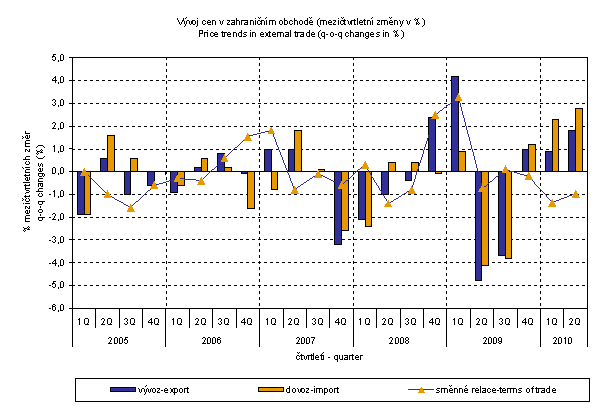
External trade price development was widely affected also by the CZK exchange rate to the leading foreign currencies.
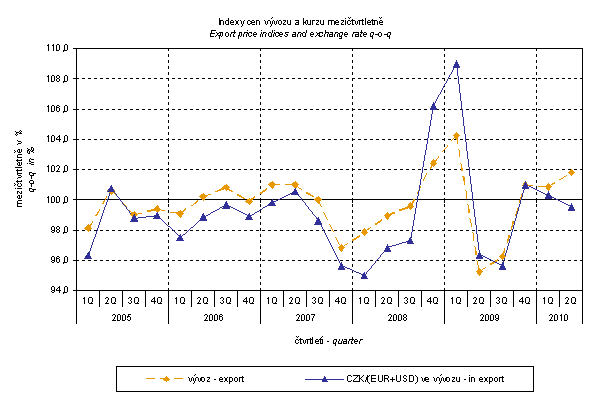
The q-o-q exchange rate index includes two most important currencies from the aspect of the Czech external trade, i.e. EUR and USD; q-o-q indices of CZK exchange rates to these currencies were weighted by the weight, which pertains to those currencies in the export price index and import price index.
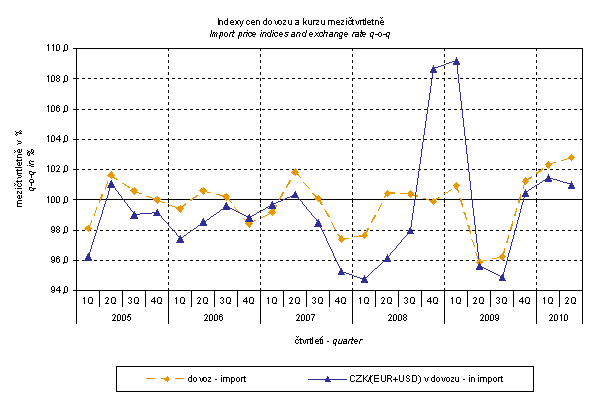
The above graphs clearly show that in both the imports and exports, external trade prices have a strong relation to exchange rate impacts. This relation could naturally be even stronger in m-o-m comparison; however, also in q-o-q index it is relatively strong as shown in graphs. It is rather logical conclusion because the contracts with foreign entities are, as a rule, signed for a longer period of the time and the longer is the contract period, the stronger is the relation to exchange rates.
Year-on-year comparison:
Export prices in Q2 2010 decreased by 0.3% (in Q1 by 6.6%). More marked drop was reported for prices of 'machinery and transport equipment' by 2.8%, 'miscellaneous manufactured articles' by 2.6% and 'manufactured goods classified chiefly by material' by 1.5%. Prices grew most in 'crude materials, inedible, except fuels' by 36.4%, 'chemicals and related products' by 10.9% and 'mineral fuels, lubricants and related materials' by 10.1%.
Import prices in Q2 2010 increased by 2.5% (in Q1 -4.5%). Prices grew for 'mineral fuels, lubricants and related materials' by 29.7%, 'manufactured goods classified chiefly by material' by 1.2% and 'chemicals and related products' by 0.2%. Prices in other observed groups dropped. Among more important groups falling were prices of 'miscellaneous manufactured articles' (-3.2%), 'crude materials, inedible, except fuels' (-2.2%) a 'machinery and transport equipment' (-0.4%).
Terms of trade reached in Q2 2010 the value of 97.3% (i.e. by 0.5 p.p. less than in Q1) and for the second quarter they continue to show negative values – see graph below. Negative values were recorded for 'mineral fuels, lubricants and related materials' (84.9%), 'manufactured goods classified chiefly by material' (97.3%), 'machinery and transport equipment' (97.6%) and 'food and live animals' (98.1%). Among more important groups positive terms of trade values were recorded in 'crude materials, inedible, except fuels' (139.5%), 'chemicals and related products' (110.7%) and 'miscellaneous manufactured articles' (100.6%).
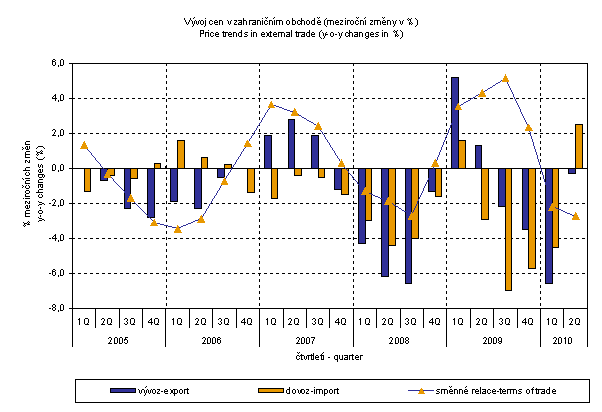
As it was shown above, external trade prices are exposed to many effects, among other things, also to the CZK exchange rate to foreign currencies. This influence is important and often even decisive mainly in m-o-m expression; however, it is very significant in the quarter-on-quarter comparison and markedly affects also the level of y-o-y external trade price indices. In Q1 2010 CZK exchange rate to EUR and USD strengthened and made prices drop, in Q2 CZK exchange rate to EUR still strengthened, but it weakened to USD. This resulted into increase of import prices (see the graph above). The development of quarterly exchange rates (y-o-y changes) is clear from the graph below.
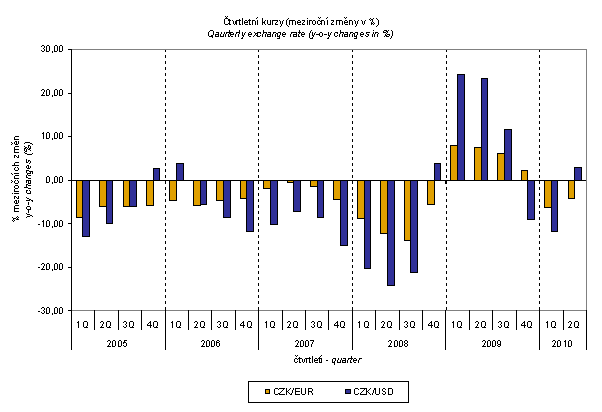
External trade price indices adjusted y-o-y by exchange rate
The CZSO makes experimental calculations of monthly external trade price indices adjusted for exchange rate influence. The method used does not allow due to many practical reasons to make a 100% exchange rate adjustment (i.e. not all observed deals made in foreign currencies are for the needs of calculations of external trade price indices also reported as such – their share makes only up to 30%). Nevertheless, it was verified that despite the increasing share of reporting in foreign currencies the currency basket remains basically constant. Thus, it can be stated that at the full exchange rate adjustment the differences between the published price indices and price indices that were adjusted would be even bigger.
In general terms, the exchange rate decreases the amount of price indices in external trade if CZK is strengthening to foreign currencies. Conversely, the exchange rate pushes the price indices up if CZK is weakening to foreign currencies. The following graphs show how significant was the exchange rate impact on the amount of export and import price indices.
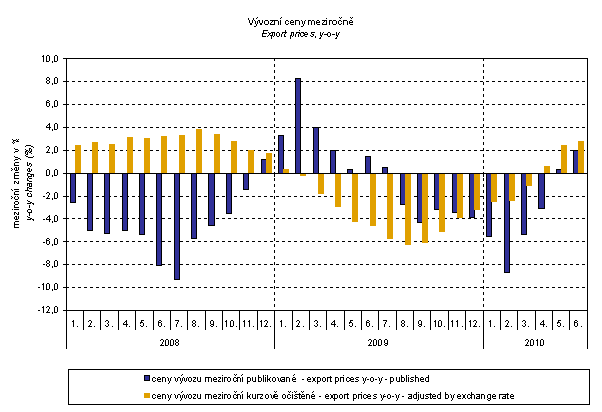
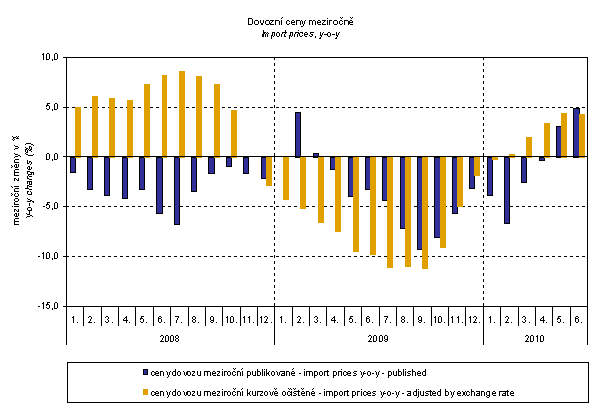
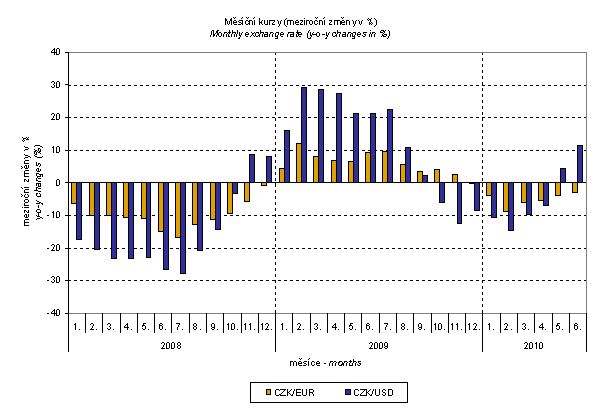
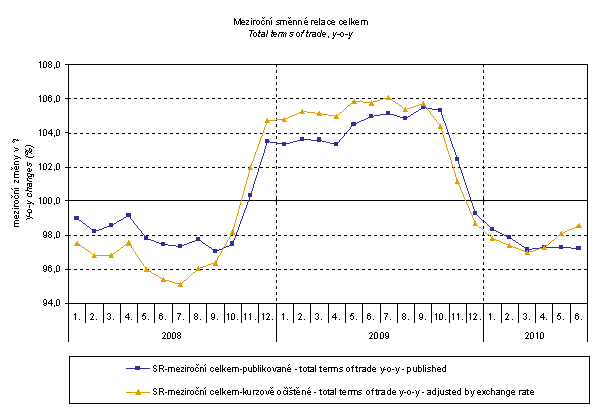
From the above graph it is clear how the exchange rate influences the year-on-year terms of trade values.
How would the terms of trade value develop if the observed groups would not include 'mineral fuels, lubricants and related materials'?
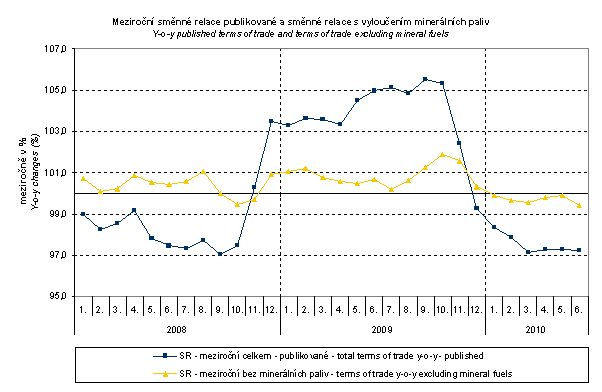
As it is clear from the above graph, 'mineral fuels, lubricants and related materials' decreased the total value of y-o-y terms of trade in the period from January to October 2008. By contrast, from November 2008 to November 2009 'mineral fuels, lubricants and related materials' had an upward effect on the terms of trade. It is most obvious just in Q2 and Q3 2009. In Q4 2009 the situation began to reverse and in December 2009 'mineral fuels, lubricants and related materials' again had a downward effect on the terms of trade value. It is naturally related to the world market price development, especially to crude oil prices. Import prices, which compared to export prices, include higher proportion of crude materials, respond more sensitively to price turbulences and therefore when prices of crude materials go up, terms of trade, as a rule, go down and, conversely, when prices of crude materials fall, terms of trade grow.
The following table shows the published decomposition of increases in export and import price indices adjusted by exchange rate influences (News Releases, Table 2). This decomposition clearly illustrates how many percentage points each group "contributes" to the index because of exchange rate effects.
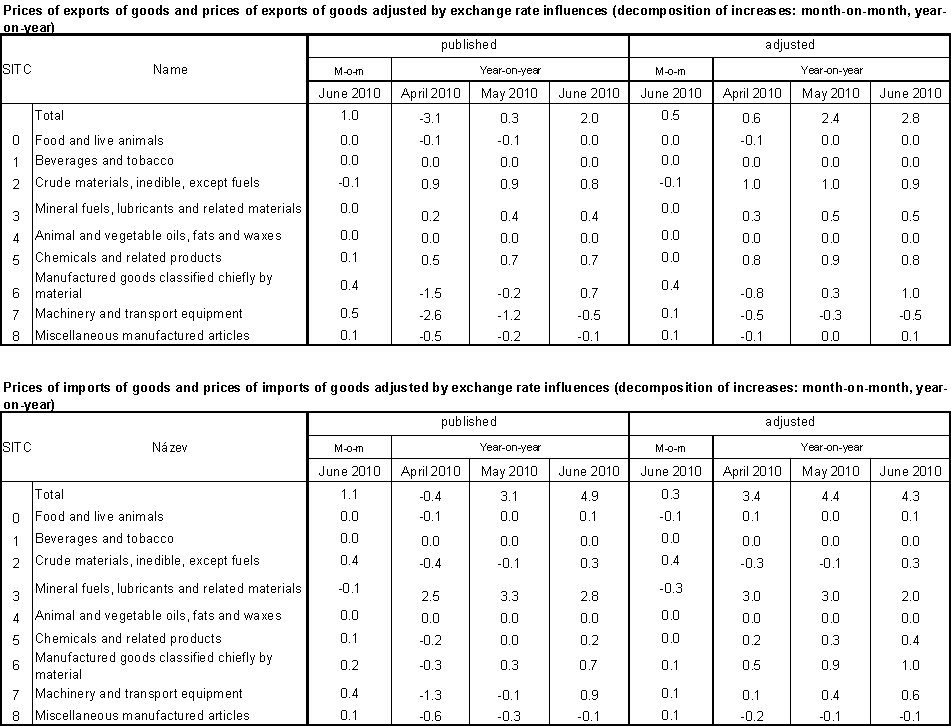
The following table shows published external trade price indices without adjustment.
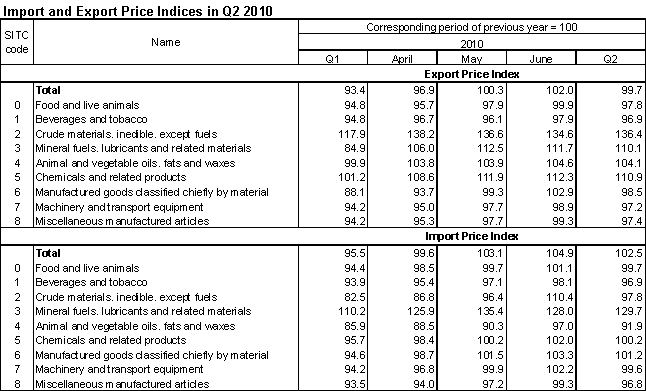
Prepared by: Vladimír Klimeš, price statistics department
Branch director: Jiří Mrázek, tel. 274 052 533
Contact: Information Services Unit - Headquarters, tel.: +420 274 056 789, email: infoservis@czso.cz










